Honestly I think the food is one of the absolute best things about living in Japan. Japanese cuisine is as varied as it is delicious, so it is such a shame that we in the west characterise a whole nation as only eating 寿司 Sushi, ご飯 Rice, 味噌汁 Miso Soup and 麺 Noodles, and dousing everything with 醤油 Soy Sauce.
Actually there are a ton of delicious foods in Japan that I had never heard of when I moved here, but I would miss so much if I ever left Japan. If you live here I hope you have at least tried most of these, and if you plan to visit I challenge you to try every one. They will definitely delight your tastebuds!
1. たこ焼き – Fried Octopus Ball
 Takoyaki is a speciality of Osaka, and is made from something similar to a savoury pancake batter combined with strips of octopus, green onions and ginger, covered in sweet takoyaki sauce and mayonnaise, and finished with 鰹節 (Katsuobushi, dried fish skin flakes). Usually they come in a ball shape the size of a large egg.
Takoyaki is a speciality of Osaka, and is made from something similar to a savoury pancake batter combined with strips of octopus, green onions and ginger, covered in sweet takoyaki sauce and mayonnaise, and finished with 鰹節 (Katsuobushi, dried fish skin flakes). Usually they come in a ball shape the size of a large egg.
This was one of the first Japanese foods I tried when I arrived here as I trained for my first English teaching job in Osaka. First time I actually didn’t like it because of the very strong flavour of the katsuobushi. It’s basically flakes of dried fish skin so it didn’t agree with my British palette. The next time I tried it I asked to have no katsuobushi and I liked it much more.
This picture here is from Asuka, my favourite Takoyaki place in Osaka (in Moriguchi-shi station). Their style is a bit different but the recipe they use is so great that it doesn’t need the Takoyaki sauce or mayo to taste absolutely fantastic.
2. お好み焼き – Savoury Pancakes from Osaka
Another delicacy from Osaka, those guys really know how to make amazing food! Okonomiyaki is a delicious kind of pancake that they often make at your table in restaurants here. It is made with cabbage cooked in a batter, optionally with pork or seafood, and then topped with Okonomiyaki sauce (like Worcestershire but thick!) and mayonnaise and some of that katsuobushi that I always ask to have without.
My favourite variant is called モダン焼き (Modern Yaki), where they also add 焼きそば (yaki soba) into the mix. It is amazing and I always have Okonomiyaki whenever I visit Osaka.
3. とんかつ/かつ丼 – Japanese Style Fried Pork Cutlet/On Rice
 This is probably my favourite Japanese food aside from Sushi. Tonkatsu is Japanese style fried pork cutlet, and is usually served with cabbage, 漬物 (Tsukemono – pickled root vegetables) and a bowl of 五穀米 (Go-kokumai – Five Grain Rice). The Tonkatsu sauce goes fantastically well with the pork and the balance of flavours here really is excellent; if you ever feel like its too fatty you can just have a little bit of cabbage to refresh your palette. Usually the cabbage is おかわり無料 (free refill) so you can eat as much of the healthy part as you like!
This is probably my favourite Japanese food aside from Sushi. Tonkatsu is Japanese style fried pork cutlet, and is usually served with cabbage, 漬物 (Tsukemono – pickled root vegetables) and a bowl of 五穀米 (Go-kokumai – Five Grain Rice). The Tonkatsu sauce goes fantastically well with the pork and the balance of flavours here really is excellent; if you ever feel like its too fatty you can just have a little bit of cabbage to refresh your palette. Usually the cabbage is おかわり無料 (free refill) so you can eat as much of the healthy part as you like!
These are usually a little more expensive than your average restaurant in Japan, but still good deals can be had for 1000¥ or so, with prices rising for higher quality cuts of meat.
4. お茶漬け – Hot Japanese Tea on Rice
 Ochazuke is a pretty unique dish that a lot of my Gaijin friends in Japan haven’t ever tried. It is basically rice with tea poured over it, often with some combination of 梅干し (Umeboshi – pickled plum), 海苔 (Nori – seaweed) perhaps with 鮭 (Shake, pronounced sha-keh; salted salmon) on top.
Ochazuke is a pretty unique dish that a lot of my Gaijin friends in Japan haven’t ever tried. It is basically rice with tea poured over it, often with some combination of 梅干し (Umeboshi – pickled plum), 海苔 (Nori – seaweed) perhaps with 鮭 (Shake, pronounced sha-keh; salted salmon) on top.
It is a very delicious and healthy meal, and pretty easy to make at home, but I haven’t seen it often in restaurants in Japan. This picture on the left is one in Shinjuku station, the most travelled station in the world.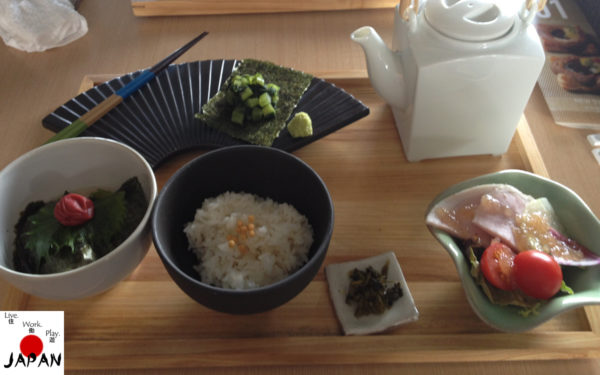
This other picture is in Iizuka, Fukuoka, the polar opposite of the hustle and bustle of Shinjuku, and my first home in Japan. It was at a pretty awesome Green Tea themed restaurant but I can’t for the life of me remember what it is called, as I haven’t been there in nearly four years now.
5. 納豆 – Fermented Sticky Soybeans
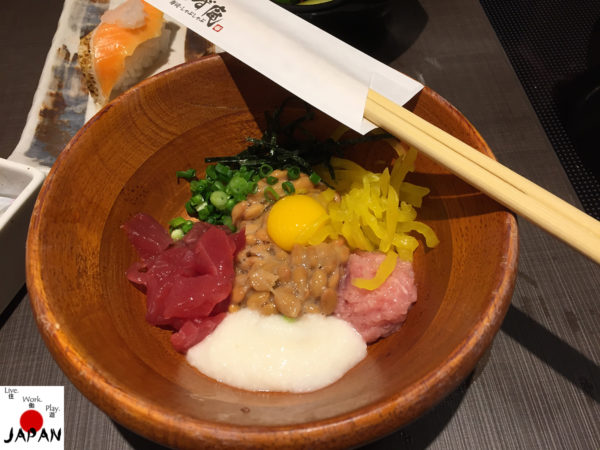 This one is a really odd food that you owe it to yourself to try. Natto is a sticky fermented soybean that is usually eaten on rice. The flavour is really hard to describe; it is kinda earthy and sour with a little bit of natural sweetness from the fermentation, and personally I find it to be absolutely amazing with a bowl of rice, some ねぎ (spring onions), 漬物 (pickled vegetables) and a poached (or raw) egg on top (玉かけ). So it isn’t served like it is on the React channel where they put a ton of natto on top of a tiny bit of rice. That would be too much natto even for me!
This one is a really odd food that you owe it to yourself to try. Natto is a sticky fermented soybean that is usually eaten on rice. The flavour is really hard to describe; it is kinda earthy and sour with a little bit of natural sweetness from the fermentation, and personally I find it to be absolutely amazing with a bowl of rice, some ねぎ (spring onions), 漬物 (pickled vegetables) and a poached (or raw) egg on top (玉かけ). So it isn’t served like it is on the React channel where they put a ton of natto on top of a tiny bit of rice. That would be too much natto even for me!
It is definitely a love it or hate it kind of food. I love it, my Japanese girlfriend hates it with a passion.
It also happens to be one of the healthiest foods in the world, a veritable super-food, and one of the cheapest here in Japan. You can buy a pack of three of them for about 80¥. It may well be one of the foods that contributes to Japanese people’s incredibly high life expectancy.
6. しゃぶしゃぶ – Thin Cuts of Meat Cooked in Sauce
I love Shabu Shabu, and it is one of the foods I recommended here as something that your visiting family would like as a first dinner in Japan, as it is distinctly Japanese but still familiar enough for us meat eating westerners to enjoy without upsetting our delicate tummies.
Usually Shabu Shabu places will have some kind of 食べ放題, all-you-can-eat for two hours or so, and they have other things besides meat and vegetables. The one near my place in Tokyo also has sushi and a variety of great desserts which also come as part of your all-you-can-eat ticket price. Excellent value to be had if you like to eat a lot, as I do.
meat off the chicken wings as possible!
By far the most famous of all Tebasaki restaurants in Nagoya is 山ちゃん (Yamachan). I love Tebasaki but usually I will only get it as a side in an 居酒屋 (izakaya, a place for eating and drinking with friends or co-workers) now, as I don’t think I’m built to have that much chicken. The picture below isn’t hyperbole, that is actually what they give you on a plate to share between your friends!
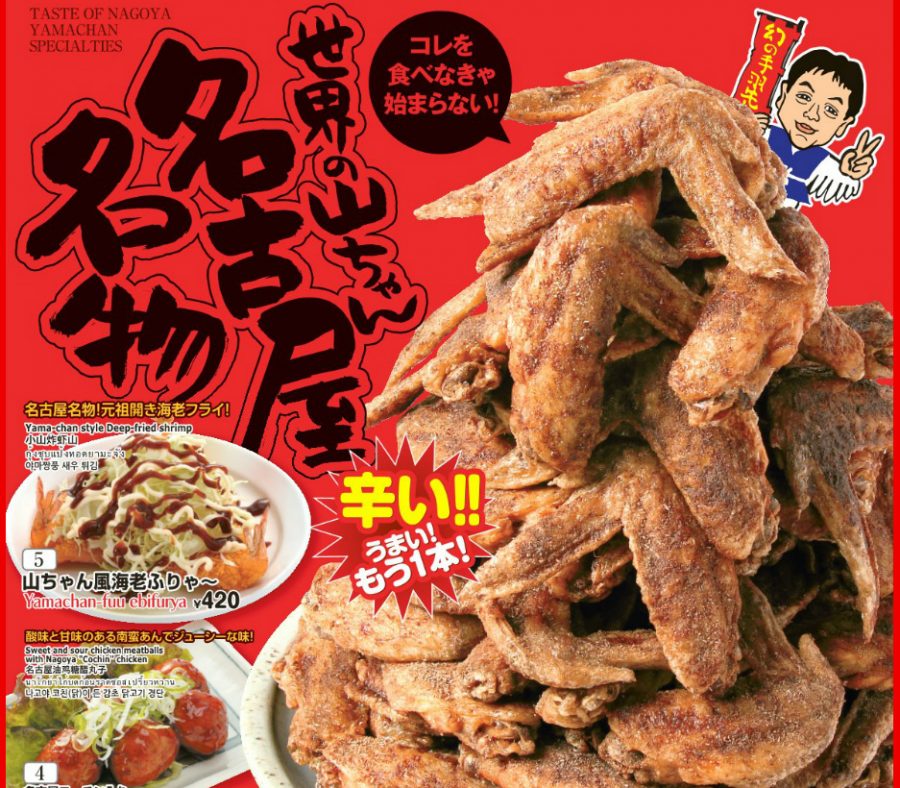
That’s a lot of chicken!
And that is our list! How many have you tried before?
7. 大学芋 – Sweet Sesame Fried Sweet Potato
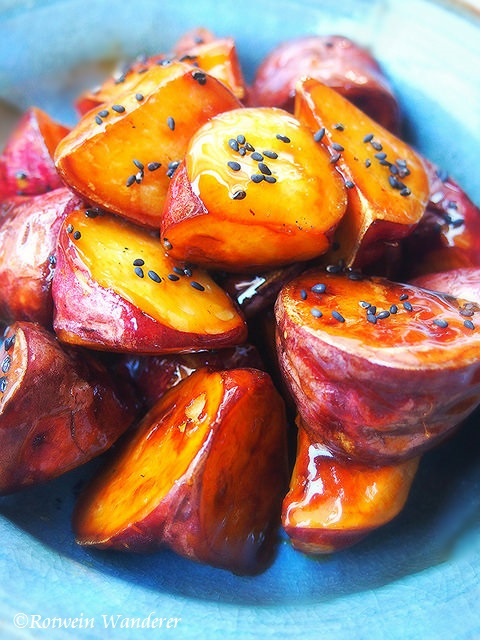 Oh, one of the best snacks in the world, Daigakuimo is just fantastic. It is a fried sweet potato glazed with a honey sauce and topped with sesame seeds.
Oh, one of the best snacks in the world, Daigakuimo is just fantastic. It is a fried sweet potato glazed with a honey sauce and topped with sesame seeds.
The potato is sealed when it is fried in oil so the insides become almost creamy in their texture, and with the crunchy sweet outside it becomes a perfect snack when you want something not too unhealthy but crazy delicious.
I make them at home all the time, but always end up making them too hard, too soft, not sweet enough or just not right in some way. Pick some up from somewhere like Edo Town 川越市 (Kawagoe city) in Saitama and enjoy all the variations and local styles.

Edo Town’s most popular sweet potato crisps – fantastic!
8. オムライス – Omelette on Rice.
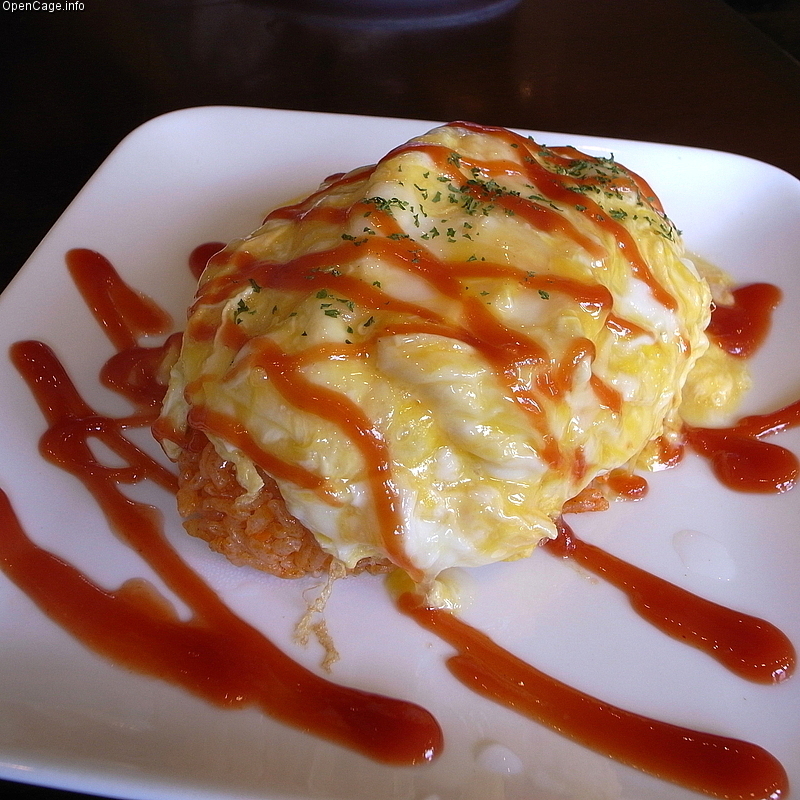
Exactly as it sounds, get some vegetable fried rice, put an omelette on top and a little ketchup or sauce and you have Omurice. It is fairly simple but tasty and doesn’t take long if you want to try making it at home.
You can have a few kinds of different toppings on your omelette, and different places have different styles, but personally I’m a big fan of the one with Curry sauce. Speaking of which…
9. カレー – Japanese Style Curry.
This is a sweet Japanese style curry sauce that shares little in common with what you might be used to when you think of curry, and is very different from Indian or Thai. For one thing, it is most definitely not spicy, but it is pretty delicious and tastes really good when combined with other Japanese foods like in カツカレー (Curry Sauce with Tonkatsu) or カレーうどん (curry with udon noodles).
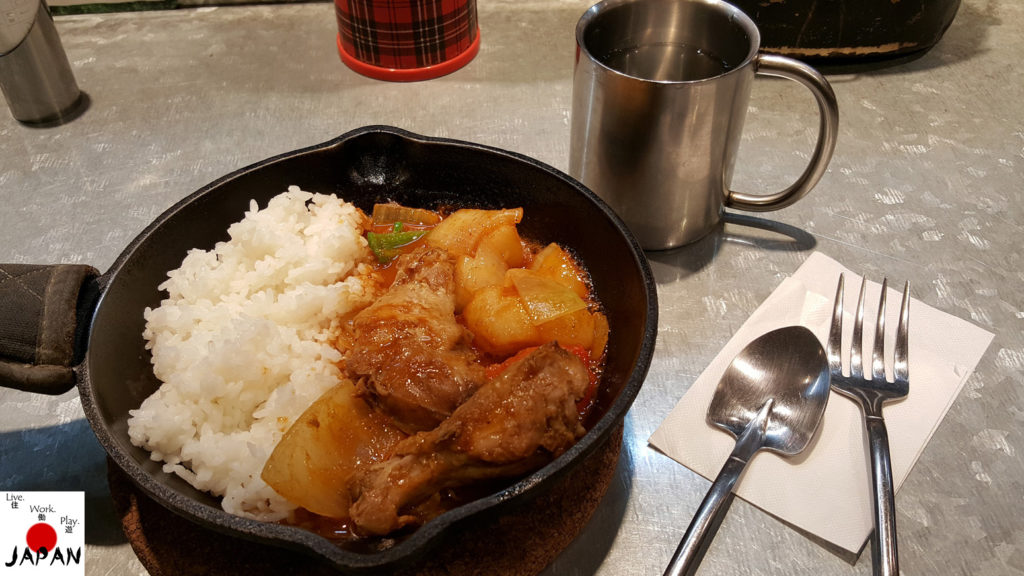
One of my favourite Japanese Curry places in Shinagawa Station – CampExpress!
Some important advice about Japanese style curry: You can go to a Japanese curry place like Coco Ichiban and ask for whatever level of spice you like, but I would recommend never going higher than medium. This is not because I don’t like spicy food because I really really do, but mainly because all they do to make the food spicy is add more curry powder, and the flavours go out of balance and it just becomes less awesome. Stick to the Japanese curry’s strength, and that is a sweet sauce, not a spicy one!
10. から揚げ – Japanese Style Fried Chicken
Kara-age is an awesome fried chicken that I absolutely love. I actually used to grab one nearly every day after finishing teaching at 英会話 (Eikaiwa – a type of English school) late at night from this local place near my house, and the juicy chicken and crunchy exterior are really great and very different from something like KFC.
The coating is more like a batter than just breadcrumbs and spices that you might expect from other kinds of fried chicken, but personally I find it to be delicious and very easy to eat. In Japan a food like this that you can eat without thinking about is called 飲みやすい meaning that it’s easy to drink it down.
11. 肉まん 551 蓬莱 – Steamed pork buns.
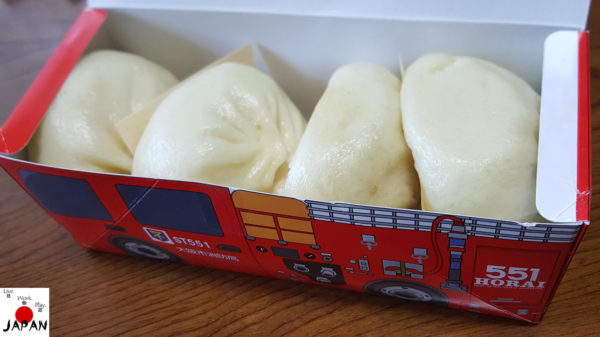 This Niku-man is excellent. I know Niku-man is a Chinese style steamed pork bun, but this particular brand in Japan makes a very uniquely awesome Niku-man that is pretty incredible! Horai 551 is based in Osaka and they make the most incredible gourmet pork buns I have ever tasted. Put a little bit of mustard and 醤油 (shouyu – soy sauce) on top and it is just face melting! Unfortunately I’ve never seen them outside of Osaka, but I always pick up a box when I go there because they are just so fantastic! They keep for a few days so you can microwave them if you dab a little water on first to stop them from drying out. That’s breakfast for a few days.
This Niku-man is excellent. I know Niku-man is a Chinese style steamed pork bun, but this particular brand in Japan makes a very uniquely awesome Niku-man that is pretty incredible! Horai 551 is based in Osaka and they make the most incredible gourmet pork buns I have ever tasted. Put a little bit of mustard and 醤油 (shouyu – soy sauce) on top and it is just face melting! Unfortunately I’ve never seen them outside of Osaka, but I always pick up a box when I go there because they are just so fantastic! They keep for a few days so you can microwave them if you dab a little water on first to stop them from drying out. That’s breakfast for a few days.

In the Horai 551 open kitchen, just before going in the oven.
12. 手羽先 – Highly seasoned Chicken, and lots of it.
Speciality of Nagoya, Tebasaki is chicken wings highly seasoned with salt and pepper, eaten by the plate-load. There is even a little part of the menu that shows you the fastest and most efficient ways to get as much chicken in your face as possible! Amazing!



